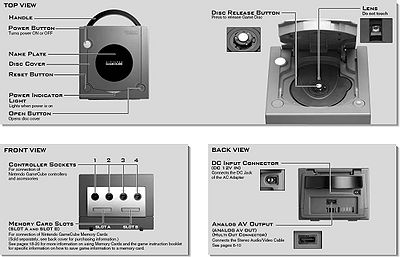| Site Notice |
|---|
|
We have a limited coverage policy. Please check our coverage page to see which articles are allowed. |
Difference between revisions of "Nintendo GameCube"
m (linking) |
m |
||
| Line 62: | Line 62: | ||
==Games== | ==Games== | ||
| + | {{seealso|Category:Nintendo GameCube games}} | ||
==Accessories== | ==Accessories== | ||
| Line 83: | Line 84: | ||
* [[Nintendo GameCube Controller]] | * [[Nintendo GameCube Controller]] | ||
* [[Nintendo GameCube Microphone]] | * [[Nintendo GameCube Microphone]] | ||
| + | |||
| + | ==References== | ||
| + | <div class="references-small" style="height:175px; overflow: auto; padding: 5px"> | ||
| + | <references/> | ||
| + | </div> | ||
| + | == External links == | ||
| + | <!--* Wikipedia Link --> | ||
| + | <!--* Affiliate Wiki Link, if Any. --> | ||
| + | <!--* Strategy Wiki Link --> | ||
| + | |||
| + | |||
{{stub}} | {{stub}} | ||
{{Nintendo console}} | {{Nintendo console}} | ||
[[Category:Consoles]] | [[Category:Consoles]] | ||
Revision as of 21:19, 31 January 2011
| Nintendo GameCube ニンテンドーゲームキューブ Nintendō Gēmu Kyūbu | ||||||||||
| ||||||||||
| ||||||||||
| ||||||||||
| ||||||||||
| ||||||||||
|
The Nintendo GameCube (Japanese: ニンテンドーゲームキューブ), officially abbreviated GCN or NGC is Nintendo's sixth-generation home console. The console was released on September 14, 2001 in Japan, November 18, 2001 in North America, May 3, 2002 in Europe, and May 17, 2002 in Australia. It is a powerful system, with a compact design, four controller ports, a controller with an ergonomic design, small but large-capacity discs, a large game library, connectivity with the Game Boy Advance and a form of online play. The console's surface has three buttons on top: Open, Reset, and Power. In 2006, it was succeeded by Wii, which also features ports for most GameCube hardware as well as compatibility for its software. The system's lifespan ended in 2007.
There were four colors that the Nintendo GameCube was released in: Purple, Black, Orange, and Silver.
A special version of the GameCube was released by Panasonic with the ability to play DVDs and audio CDs as well as GameCube games. It was named the Panasonic Q and was only available in Japan.
Contents
Features
The GameCube console is capable of hosting up to four player games with its four controller ports. One such four player title is The Legend of Zelda: Four Swords Adventures. As the system was a disc player instead of a cartridge based console, separate memory cards had to be purchased to save game data. Only two slots were available for memory card usage. GameCube discs are smaller than the industry standard of 5 inches, the smaller discs measured 3.5 inches in diameter.
Development
The GameCube's codename during development was "Dolphin".
System specs
- MPU ("Microprocessor Unit")*: Custom IBM Power PC "Gekko"
- Manufacturing process: 0.18 micron IBM copper wire technology
- Clock frequency: 485 MHz
- CPU capacity: 1125 Dmips (Dhrystone 2.1)
- Internal data precision: 32-bit Integer & 64-bit floating-point
- External bus: 1.3GB/second peak bandwidth (32-bit address space, 64-bit data bus 162 MHz clock)
- Internal cache L1: instruction 32KB, data 32KB (8 way) L2: 256KB (2 way)
- System LSI: Custom ATI/Nintendo "Flipper"
- Embedded frame buffer: Approx. 2MB sustainable latency : 6.2ns (1T-SRAM)
- Embedded texture cache: Approx. 1MB sustainable latency : 6.2ns (1T-SRAM)
- Texture read bandwidth: 10.4GB/second (Peak)
- Main memory bandwidth: 2.6GB/second (Peak)
- Pixel depth: 24-bit color, 24-bit Z buffer
- Image processing functions: Fog, subpixel anti-aliasing, 8 hardware lights, alpha blending, virtual texture design, multi-texturing, bump mapping, environment mapping, MIP mapping, bi-linear filtering, trilinear filtering, anisotropic filtering, real-time hardware texture decompression (S3TC), real-time decompression of display list, HW 3-line deflickering filter.
Games
| See also: Category:Nintendo GameCube games |
Accessories
- WaveBird Wireless Controller
- Nintendo GameCube Controller
- DK Bongo Controller
- Nintendo GameCube Game Boy Advance Cable
- Nintendo GameCube Game Boy Player
- Nintendo GameCube Broadband Adapter
- Nintendo GameCube Modem Adapter
- Memory Cards
Reception
Compared to Nintendo's other home consoles, the GameCube sold rather poorly. In total, less than 22 million units were sold, mostly in America. Although this was more than the ill-fated Dreamcast, Microsoft's XBox and especially Sony's PlayStation 2 outsold it.[1]
The GameCube was hurt by several factors. One of them was its image as a "kiddy" console, in a market that was being increasingly dominated by older audiences and games with "Teen" and "Mature" ratings, such as Grand Theft Auto. Unlike its competitors, the GameCube lacked the ability to play DVDs and online play. Although it managed to sell ahead of the XBox from 2001 to 2003, a lack of new titles meant caused the system to climax long before its competitors.
Despite the subpar sales, the GameCube and many of its titles have received critical acclaim. IGN rated the GameCube the 16th best console of all time, citing its impressive technology and well great titles. [2] It had a total of 41 titles to sell over a million units, including three to exceed 5 million sales.[3] The best selling game on the system, Super Smash Bros. Melee, is the best selling fighting game of all time save for its sequel. Some GameCube games, such as Metroid Prime, Resident Evil 4, and The Legend of Zelda: Twilight Princess, are considered to be some of the greatest games ever made.
See also
References
External links
| This article is a stub. You can help NintendoWiki by expanding it. |
| |||||||||||||||||||||
| |||||||||||||||||||||
| |||||||||||||||||||||


